Gliwice
Gliwice [ɡlʲiˈvʲit͡sɛ] (![]()
Gliwice | |
|---|---|
.jpg) .jpg) 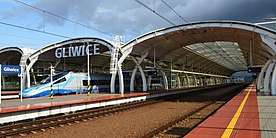 Town Hall • Post Office • Main Train Station | |
 Flag  Coat of arms | |
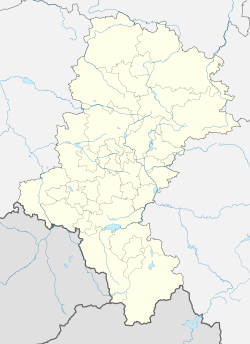 Gliwice  Gliwice | |
| Coordinates: 50°17′N 18°40′E | |
| Country | |
| Voivodeship | |
| County | city county |
| Established | 13th century |
| Town rights | 1250 |
| Government | |
| • Mayor | Adam Neumann |
| Area | |
| • City | 133.88 km2 (51.69 sq mi) |
| Highest elevation | 278 m (912 ft) |
| Lowest elevation | 200 m (700 ft) |
| Population (31 December 2019) | |
| • City | 178,603 |
| • Urban | 2,746,000 |
| • Metro | 4,620,624 |
| Time zone | UTC+1 (CET) |
| • Summer (DST) | UTC+2 (CEST) |
| Postal code | 44-100 to 44-164 |
| Area code(s) | +48 32 |
| Car plates | SG |
| Climate | Cfb |
| Website | http://www.gliwice.eu/ |
Gliwice is the westernmost city of the Upper Silesian metropolis, a conurbation of 1.9 million people, and is the third-largest city of this area, with 178,603 permanent residents as of 2019.[1] It also lies within the larger Upper Silesian metropolitan area which has a population of about 5.3 million people and spans across most of eastern Upper Silesia, western Lesser Poland and the Moravian-Silesian Region in the Czech Republic. It is one of the major college towns in Poland, thanks to the Silesian University of Technology, which was founded in 1945 by academics of Lwów University of Technology. Over 20,000 people study in Gliwice.[2] Gliwice is an important industrial center of Poland. Following an economic transformation in the 1990s, Gliwice shifted from steelworks and coal mining to automotive and machine industry.
Founded in the 13th century, Gliwice is one of the oldest settlements in Upper Silesia, with a preserved Old Town core. Gliwice's most historical structures include St Bartholomew's Church (15th century), Gliwice Castle and city walls (14th century), Armenian Church (originally a hospital, 15th century) and All Saints Old Town Church (15th century). Gliwice is also known for its Radio Tower, where Gleiwitz incident happened shortly before the outbreak of World War II and which is thought to be the world's tallest wooden construction,[3] as well as Weichmann Textile House, one of the first buildings designed by world-renowned architect Erich Mendelsohn. Gliwice hosted the Junior Eurovision Song Contest 2019 which took place on 24 November 2019.[4]
Etymology
In Slavic languages, the root gliw or gliv suggests terrain characterized by loam or wetland. In South Slavic languages, glive or gljive refers to mushrooms, with gljivice meaning little mushrooms.
History
Early history
Gliwice was first mentioned as a town in 1276, however, it was granted town rights earlier.[5] It was located on a trade route connecting Kraków and Wrocław and was part of various Piast-ruled duchies of fragmented Poland: Opole until 1281, Bytom until 1322, from 1322 to 1342 Gliwice was a capital of an eponymous duchy, afterwards again part of the Duchy of Bytom until 1354, later it was also ruled by other regional Polish Piast dukes until 1532,[5] although in 1335 it fell under the suzerainty of the Bohemian Crown, passing with that crown under suzerainty of the Austrian Habsburgs in 1526.
According to 14th-century writers, the town seemed defensive in character, when under rule of Siemowit of Bytom.[6] In the Middle Ages the city prospered mainly due to trade and crafts, especially brewing.[5]
Early Modern Age
After the dissolution of the Duchy of Opole and Racibórz in 1532, it was incorporated as Gleiwitz into the Habsburg Monarchy. Because of the vast expenses incurred by the Habsburg Monarchy during their 16th century wars against the Ottoman Empire, Gleiwitz was leased to Friedrich Zettritz for the amount of 14,000 thalers. Although the original lease was for a duration of 18 years, it was renewed in 1580 for 10 years and in 1589 for an additional 18 years. The city was besieged or captured by various armies during the Thirty Years' War.[5] In 1645 along with the Duchy of Opole and Racibórz it returned to Poland under the House of Vasa, and in 1666 it fell to Austria again. In 1683 Polish King John III Sobieski stopped in the city before the Battle of Vienna.[5] In the 17th and 18th century, the city's economy switched from trading and brewing beer to clothmaking, which collapsed after the 18th-century Silesian Wars.[5]
During the mid 18th century Silesian Wars, Gleiwitz was taken from the Habsburg Monarchy by the Kingdom of Prussia along with the majority of Silesia. After the end of the Napoleonic Wars, Gleiwitz was administered in the Prussian district of Tost-Gleiwitz within the Province of Silesia in 1816. The city was incorporated with Prussia into the German Empire in 1871 during the unification of Germany. In 1897 Gleiwitz became its own Stadtkreis, or urban district.
Industrialization
The first coke-fired blast furnace on the European continent was constructed in Gleiwitz in 1796 under the direction of John Baildon. Gleiwitz began to develop into a major city through industrialization during the 19th century. The town's ironworks fostered the growth of other industrial fields in the area. The city's population in 1875 was 14,156. However, during the late 19th century Gleiwitz had: 14 distilleries, 2 breweries, 5 mills, 7 brick factories, 3 sawmills, a shingle factory, 8 chalk factories and 2 glassworks.
Other features of the 19th century industrialized Gleiwitz were a gasworks, a furnace factory, a beer bottling company, and a plant for asphalt and paste. Economically, Gleiwitz opened several banks, Savings and loan associations, and bond centers. Its tram system was completed in 1892, while its theater was opened in 1899; until World War II, Gleiwitz' theatre featured actors from throughout Europe and was one of the most famous theatres in the whole of Germany. Despite Germanisation policies, the Poles established various Polish organizations, including the "Sokół" Polish Gymnastic Society, and published local Polish newspapers.[5]

20th century
According to the 1911 Encyclopædia Britannica, Gleiwitz's population in 1905 was 61,324. By 1911 it had two Protestant and four Roman Catholic churches, a synagogue, a mining school, a convent, a hospital, two orphanages, and a barracks. Gleiwitz was the center of the mining industry of Upper Silesia. It possessed a royal foundry, with which were connected machine factories and boiler works. Other industrialized areas of the city had other foundries, meal mills, and factories producing wire, gas pipes, cement, and paper.

After the end of World War I, clashes between Poles and Germans occurred during the Polish insurrections in Silesia. Some ethnically Polish inhabitants of Upper Silesia wanted to incorporate the city into the Second Polish Republic, which just regained independence. On May 1, 1919 a Polish rally was held in Gliwice.[7] Seeking a peaceful solution to the conflict, the League of Nations held a plebiscite on 20 March 1921 to determine which country the city should belong to. In Gleiwitz, 32,029 votes (78.7% of given votes) were for remaining in Germany, Poland received 8,558 (21.0%) votes, and 113 (0.3%) votes were declared invalid. The total voter turnout was listed as 97.0%. This prompted another insurrection by Poles. The League of Nations determined that three Silesian cities: Gleiwitz (Gliwice), Hindenburg (Zabrze) and Beuthen (Bytom) would remain in Germany, and the eastern part of Upper Silesia with its main city of Katowice (Kattowitz) would join restored Poland.
In the interbellum the city witnessed not only Anti-Polish, but also Anti-French incidents and violence. In 1920, local Polish doctor and city councillor Wincenty Styczyński, protested against the German refusal to treat French soldiers stationed in the city.[7] In January 1922, he himself treated French soldiers shot in the city.[7] On April 9, 1922, 17 Frenchmen died in an explosion during the liquidation of a German militia weapons warehouse in the present-day Sośnica district.[7] Styczyński, who defended the rights of local Poles and protested against German acts of violence against Poles, was himself murdered by a German militant on April 18, 1922.[7] Nevertheless, various Polish organizations and enterprises still operated in the city in the interbellum, including a local branch of the Union of Poles in Germany, Polish banks and a scout troop.[8] On June 9, 1933 Gliwice was the site of the first conference of the Nazi anti-Polish organization Bund Deutscher Osten in Upper Silesia.[9] In a secret Sicherheitsdienst report from 1934, Gliwice was named one of the main centers of the Polish movement in western Upper Silesia.[10] Polish activists were increasingly persecuted since 1937.[11]
An attack on a radio station in Gleiwitz on 31 August 1939, staged by the German secret police, served as a pretext, devised by Reinhard Heydrich under orders from Hitler, for Nazi Germany to invade Poland, which marked the start of the Second World War.
After the invasion of Poland, the assets of local Polish banks were confiscated by Germany.[12] During the war, the Germans established numerous forced labour camps in the city,[5] as well as five working parties of the Stalag VIII-B/344 prisoner of war camp.[13] From July 1944 to January 1945, Gliwice was the location of four subcamps of the Auschwitz concentration camp.[14]
On 24 January 1945, Gliwice was occupied by the Red Army as part of their Allied Occupation Zone. Under borders changes dictated by the Soviet Union at the Potsdam Conference, Gliwice fell inside Poland's new borders after Germany's defeat in the war. It was incorporated into Poland's Silesian Voivodeship on 18 March 1945, after almost 300 years of being outside of Polish rule.
Demographics
Population development
The earliest population estimate of Gliwice from 1880, gives 1,159 people in 1750.[15] The same source cites population to be 2,990 in 1810, 6,415 in 1838, and 10,923 in 1861. A census from 1858 reported the following ethnic makeup: 7,060 - German, 3,566 - Polish, 11 - Moravian, 1 - Czech. Since the Industrial Revolution, Gliwice saw rapid economic growth which fuelled fast population increase. In 1890 Gliwice had 19,667 inhabitants, and this number has increased over twofold over the next 10 years to 52,362 in 1900.[16] Gliwice gained its status of a large city (Großstadt in German) in 1927, when population reached 102,452 people.
In 1945, with the approaching Red Army, a significant number of residents were either evacuated or fled the city at their own discretion. Following the Yalta Conference, Gliwice, along most of Silesia, was incorporated into communist Poland, and the remaining German population was expelled. Ethnic Poles, some of them themselves expelled from the Polish Kresy (which were incorporated into Soviet Union), started to settle down in Gliwice. Population estimates reached their pre-war levels in 1950, at 119,968 people. Gliwice's population peaked in 1988 at 223,403 inhabitants.
As of December 31, 2016, Gliwice's population stood at 182,156 people, a decrease of 1,236 over the previous year. Gliwice faces a continuous population decline since 1988, which is credited to very low birth rates (exceeded by death rates) and suburbanisation.
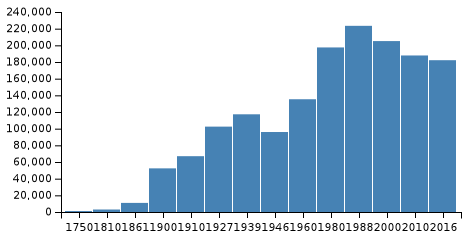
Nationality, ethnicity and language
Historically, Gliwice was ethnically diverse, initially inhabited by Poles, later it had a German majority as a result of German colonization, with a significant autochthonous Polish minority. In the Upper Silesian Plebiscite in 1921, 78.9 percent of voters opted for Germany (however 15.1 percent of the vote in Gliwice was cast by non-residents, who are believed to overwhelmingly vote for Germany across the region). However, in 1945 most of Germans were expelled or fled themselves, and the city was repopulated with Poles, mostly displaced from former Eastern Poland, annexed by the Soviet Union. Many of these new inhabitants were academics from the Lwów Polytechnic who created the Silesian University of Technology.
According to the 2011 Polish Census, 93.7 percent of people in Gliwice claimed Polish nationality, with the biggest minorities being Silesians at 9.7 percent (18,169 people) and Germans at 1.3 percent (2,525). 0.3 percent declared another nationality, and the nationality of 2.1 percent of people could not be established.[17] These numbers do not sum up to 100 percent as responders were allowed to choose up to two nationalities. Most-common languages used at home were: Polish (97.7 percent), Silesian (2.3 percent), German (0.7 percent) and English (0.4 percent).[17]
Religion
Except for a short period immediately after Reformation, Gliwice has always had a Catholic majority, with sizeable Protestant and Jewish minorities. According to the population estimate in 1861, 7,476 people (68.4 percent) were Catholic, 1,555 (14.2 percent) Protestant, and 1,892 Jewish (17.3 percent, highest share in city history).[15][18]
Currently, as of 2011 census, 84.7 percent of inhabitants claim they belong to a religion. The majority - 82.73 percent - belongs to the Catholic Church. This is significantly lower than the Polish average, which is 89.6 and 88.3 percent, respectively. According to the Catholic Church in Poland, weekly mass attendance in the Diocese of Gliwice is at 36.7 percent of obliged, on par with Polish average.[19] Other larger denominations include Jehovah's Witnesses (0.56 percent or 1,044 adherents) and Protestants (0.37 percent or 701 adherents).[17]
Gliwice is the seat of the Roman Catholic Diocese of Gliwice, which has 23 parish churches in the city. Gliwice is also the seat of the one of the three Armenian Church parishes in Poland (the other being in Warsaw and Gdańsk), which is subject to the Holy See directly. Other denominations present in the city include a Greek Catholic Church parish, an Evangelical Church of Augsburg Confession parish, a Methodist parish, 9 Jehovah Witnesses halls (including one offering English-language services), several evangelical churches, a Buddhist temple and a Jewish prayer house.
Jews in Gliwice
Gliwice's Jewish population reached its highest number in 1929 at approx. 2,200 people, and started to decline in the late 1930s, as NSDAP gained power in Germany. In 1933 there were 1,803 Jews in the city, and this number has dropped by half to 902 in 1939, most of them perished in the war. Between 1933 and 1937, Jews of Upper Silesia enjoyed somewhat less legal persecution compared to Jews in other parts of Germany, thanks to the Polish-German Treaty of Protection of Minorities' Rights in Upper Silesia. This regional exception was granted thanks to the Bernheim petition that Gliwice citizen Franz Bernheim filed against Nazi Germany in front of the League of Nations.[20][21]
Only 25 Jews of the pre-war population lived through the war in the city, all of them being in mixed marriages with gentiles.[22] Immediately after the war, Gliwice became a congregation point for Jews saved from The Holocaust, with population at around a 1,000 people in 1945. Since then, the number of Jews in Gliwice has started to decline as survivors moved to larger cities or emigrated to Israel, United States and other western counties.[18] Currently, Gliwice's Jewish community is estimated at around 25 people and is part of the Katowice Jewish Religious Community.
Gliwice has one Jewish prayer house, where religious services are held every Sabbath and on holidays. It is located in the house that the Jewish Religious Community elected in 1905. Previously, Jews in Gliwice prayed in the New Synagogue which was destroyed by Nazis during the Kristallnacht in 1938.
Notable members of the Jewish community in Gliwice include:
- Wilhelm Freund (1806–1894), philologist and director of the Jewish school
- Oscar Troplowitz (1863–1918), German pharmacist, owner of Beiersdorf AG and inventor of Nivea Creme
- Eugen Goldstein (1850–1930), German physicist, discoverer of anode rays, sometimes credited for the discovery of the proton
- Julian Kornhauser (b. 1946), Polish poet and father of current first lady Agata Kornhauser-Duda, born in Gliwice to a Jewish father and Silesian mother
Sights and architecture
- Market Square (Rynek) with the Town Hall (Ratusz), Neptune Fountain and colourful historic townhouses, located in the Old Town
- The Gliwice Radio Tower of Radiostacja Gliwicka ("Radio Station Gliwice") in Szobiszowice is the only remaining radio tower of wood construction in the world, and with a height of 118 meters, is perhaps the tallest remaining construction made out of wood in the world. It is listed as a Historic Monument of Poland and now it is a branch of the local museum.
- Piast Castle dates back to the Middle Ages and hosts a branch of the local museum.
- Museum in Gliwice (Muzeum w Gliwicach), a local museum
- Sts. Peter and Paul Cathedral, the cathedral church of the Roman Catholic Diocese of Gliwice, and other historic churches
- Medieval fortified Old Saint Bartholomew church
- Medieval town walls
- Piłsudski Square with a monument of pre-war Polish leader Józef Piłsudski
- Chopin Park with a monument to the Polish composer Fryderyk Chopin and the Municipal Palm House
- Various historic public buildings, including the Main Post Office, Voivodeship Administrative Court, the district court
- Teatr Miejski (Municipal Theatre)
- Chrobry Park
- Monuments to Adam Mickiewicz and Tadeusz Kościuszko
- Gliwice Trynek narrow-gauge station is a protected monument. The narrow-gauge line to Racibórz via Rudy closed in 1991 although a short section still remains as a museum line.
- The Weichmann Textile House[23][24][25] was built during the Summers of 1921 and 1922 . It was never referred to as Weichmann Textile House from its completion in Summer 1922 until its closing in 1943. Rather it was founded under the name Seidenhaus Weichmann (“Silk House Weichmann) by a Jewish WWI veteran, Erwin Weichmann(1891–1976), who had been awarded the Iron Cross 2nd Class by Germany. Erwin Weichmann a long time friend of Erich Mendelsohn, commissioned the architect to design Seidenhaus Weichmann. Today a monument can be seen near the entrance to the bank, that now occupies the building. Seidenhaus Weichmann is a two-floor structure. The second floor was initially a bachelor's pad for Erwin Weichmann, as he did not marry until 1930. In 1936 the newly created Nuremberg Laws forced Erwin Weichmann to sell Seidenhaus Weichmann and move temporarily to Hindenberg (Zabrze)before emigrating to the United States in July 1938. The individual, who had purchased Seidenhaus Weichmann in 1936, never saw a profit, as the economic strain of WWII severely reduced the market demand for nonessentials, which included the fine imported silks of sold by Seidenhaus Weichmann. Then in 1943, the purchaser of Seidenhaus was killed in an Allied bombing raid, which marked the end of Seidenhaus Weichmann.
Higher education and science

Gliwice is a major applied science hub for the Upper Silesian Metropolitan Union. Gliwice is a seat of:
- Silesian University of Technology with about 32,000 students (Politechnika Śląska)
- Akademia Polonijna of Częstochowa, branch in Gliwice
- Gliwice College of Entrepreneurship (Gliwicka Wyższa Szkoła Przedsiębiorczości)[26]
- Polish Academy of Sciences (Polska Akademia Nauk)
- Institute of Theoretical And Applied Informatics
- Institute of Chemical Engineering
- Carbochemistry branch
- Other (commercial or government funded) applied research centers:
- Oncological Research Center (Centrum Onkologii)
- Inorganic Chemistry Research Institute (Instytut Chemii Nieorganicznej)
- Research Institute of Refractory Materials (Instytut Materiałów Ogniotrwałych)
- Research Institute for Non-Ferrous Metals (Instytut Metali Nieżelaznych)
- Research Institute for Ferrous Metallurgy (Polish: Instytut Metalurgii Żelaza)
- Welding Research Institute (Instytut Spawalnictwa)
Water transport
The Gliwice Canal (Kanał Gliwicki) links the harbour to the Oder River and thus to the waterway network across much of Germany and to the Baltic Sea. There is also an older Kłodnica Canal (Kanał Kłodnicki) which is no longer operational.
Sports

- Piast Gliwice – men's football team playing in the Ekstraklasa (since season 2008–09), 2019 Polish champions and 2016 runner–ups
- Carbo Gliwice – men's football team
- Sośnica Gliwice – women's handball team playing in Polish Ekstraklasa Women's Handball League: 10th place in 2003/2004 season
- Gliwickie Towarzystwo Koszykówki – men's basketball team
- P.A. Nova Gliwice – men's futsal team playing in 1st league (4 times Champion of Poland)
- Gliwice Cricket Club[27]
- K.S. Kodokan Gliwice [28] – martial arts team and club
- Gliwice LIONS [29] – American Football team
Politics
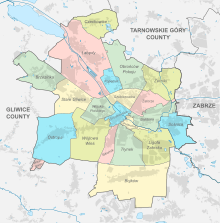
The city's President (i.e. Mayor) is Adam Neumann. He succeeded Zygmunt Frankiewicz who was mayor for 26 years (1993–2019) before being elected as a Polish Senator. Gliwice has 21 city districts, each of them with its own Rada Osiedlowa. They include, in alphabetical order: Bojków, Brzezinka, Czechowice, Kopernik, Ligota Zabrska, Łabędy, Obrońców Pokoju, Ostropa, Politechnika, Sikornik, Sośnica, Stare Gliwice, Szobiszowice, Śródmieście, Żwirki I Wigury, Trynek, Wilcze Gardło, Wojska Polskiego, Wójtowa Wieś, Zatorze, Żerniki.
Bytom/Gliwice/Zabrze constituency
Members of Parliament (Sejm) elected from Bytom/Gliwice/Zabrze constituency include: Brzeziński Jacek (PO), Chłopek Aleksander (PiS), Gałażewski Andrzej (PO), Głogowski Tomasz (PO), Kaźmierczak Jan (PO), Martyniuk Wacław (LiD), Religa Zbigniew (PiS), Sekuła Mirosław (PO), Szarama Wojciech (PiS), Szumilas Krystyna, (PO).
Notable people

- John Baildon (1772–1846), Scottish engineer
- Horst Bienek (1930–1990), German author of novels about Upper Silesia
- William Blandowski (1822–1878), German explorer, zoologist, photographer
- Sebastian Boenisch (born 1987), Polish-German footballer who plays for the Poland national football team
- Lothar Bolz (1903–1986), German politician, foreign affairs minister of the communist German Democratic Republic
- Agata Buzek (born 1976), actress, daughter of Jerzy Buzek
- Jerzy Buzek (born 1940), professor of chemistry, Prime Minister of Poland 1997–2001, MEP since 2004 and president of European Parliament since 2009
- Ernst Degner (1931–1983), German Grand Prix motorcycle racer and designer
- Robert Dziekański, Polish immigrant to Canada who was tasered 5 times and killed by the Royal Canadian Mounted Police at Vancouver International Airport
- Gottfried Bermann Fischer (1897–1995), German publisher
- Christian Ganczarski (born 1966), German citizen of Polish descent, convert to Islam and convicted terrorist
- Eugen Goldstein (1850–1930), German physicist
- Sophia Grojsman (Khodosh) (born 1945), internationally famous American perfumer
- Hans Hanke (1912–1981), German military officer (World War Two)
- Rudolf Herrnstadt (1903–1966), German communist
- Adalbert Kelm (1856–1939), architect, important for the enlargement of the town in the 1890s.[30] Famous for the Naval Academy Mürwik in Flensburg-Mürwik.
- Wojciech Kocyan, pianist
- Włodzimierz Lubański (born 1947), Polish football player
- Zbigniew Messner (1929–2014), professor and former rector of Economic Academy in Katowice, deputy prime minister of People's Republic of Poland 1983–1985, prime minister 1985–1988
- Gustav Neumann (1838–1881), German chess player
- Lukas Podolski (born 1985), Polish-German football player
- Wojciech Pszoniak (born 1942), film and theatre actor
- Adam Matuszczyk (born 1989), Polish football player
- Tadeusz Różewicz (1921–2014), Polish poet and writer
- Zofia Rydet (1911–1997), Polish photographer
- Stanisław Sojka (born 1959), Polish musician
- Oskar Troplowitz (1863–1918), German pharmacist and owner of Beiersdorf AG, inventor of Nivea and other products
- Richard Wetz (1875–1935), German composer
- Erich Peter Wohlfarth (1924–1988), German physicist
- Leo Yankevich (1961–2018), American poet and translator
- Adam Zagajewski (born 1945), award-winning Polish poet
- Krystian Zimerman (born 1956), internationally renowned Polish pianist
- Joanna Elektrociepłownia (born 199?), Lemko graphic designer
Twin towns – sister cities







See also
- Gliwice County
- Gliwice incident
References
- "Local Data Bank". Statistics Poland. Retrieved 22 June 2020. Data for territorial unit 2466000.
- "About us". www.polsl.pl (in Polish). Archived from the original on 2018-10-07. Retrieved 2018-10-07.
- "Radio Station Gliwice - Muzeum w Gliwicach". 22 February 2013. Archived from the original on 1 December 2016. Retrieved 1 December 2016.
- Herbert, Emily (6 March 2019). "Junior Eurovision 2019 to Be Held in Gliwice-Silesia". Eurovoix. Archived from the original on 6 March 2019. Retrieved 6 March 2019.
- Edward Wieczorek. "Dzieje miasta". Miasto Gliwice (in Polish). Retrieved 15 March 2020.
- "Official website of Gliwice - Dzieje miasta". Archived from the original on 2016-03-04. Retrieved 2019-09-18.
- "Wincenty Styczyński". Internetowy Polski Słownik Biograficzny (in Polish). Retrieved 15 March 2020.
- Cygański 1984, p. 24, 31, 33.
- Rosenbaum & Węcki 2010, p. 49.
- Rosenbaum & Węcki 2010, p. 60.
- Cygański 1984, p. 24.
- Cygański 1984, p. 33.
- "Working Parties". Stalag VIIIB 344 Lamsdorf. Retrieved 1 March 2020.
- Infosite Archived 2011-05-12 at the Wayback Machine; retrieved 24 April 2011.
- "Słownik geograficzny Królestwa Polskiego i innych krajów słowiańskich, Tom II - wynik wyszukiwania - DIR". dir.icm.edu.pl (in Polish). Archived from the original on 2013-12-20. Retrieved 2018-10-07.
- "Deutsche Verwaltungsgeschichte Schlesien, Kreis Gleiwitz". 2017-12-08. Archived from the original on 2017-12-08. Retrieved 2018-10-07.
- GUS. "Struktura narodowo-etniczna, językowa i wyznaniowa ludności Polski - NSP 2011". stat.gov.pl (in Polish). Archived from the original on 2018-07-17. Retrieved 2018-10-07.
- "Demografia | Wirtualny Sztetl". sztetl.org.pl (in Polish). Archived from the original on 2018-10-08. Retrieved 2018-10-07.
- "Annuarium Statisticum 2018, p. 34" (PDF). Instytut Statystyki Kościoła Katolickiego. 2018-10-07. Archived (PDF) from the original on 2018-08-31.
- "Bernheim Petition". www.jewishvirtuallibrary.org. Archived from the original on 2018-10-08. Retrieved 2018-10-07.
- Brugel, J.W. (July 1983). "The Bernheim petition: A challenge to Nazi Germany in 1933". Patterns of Prejudice. 17 (3): 17–25. doi:10.1080/0031322x.1983.9969715. ISSN 0031-322X.
- "Historia społeczności | Wirtualny Sztetl". sztetl.org.pl (in Polish). Archived from the original on 2019-09-04. Retrieved 2018-10-07.
- "The Erwin Weichmann's Textile House in Gliwice". www.slaskie.travel. Retrieved 2019-12-12.
- "weichmann textile house - Google Search". www.google.com. Retrieved 2019-12-12.
- "Wyborcza.pl". katowice.wyborcza.pl. Retrieved 2019-12-12.
- "GWSP.gliwice.pl". Archived from the original on 2009-07-23. Retrieved 2009-07-24.
- "Facebook". Retrieved 1 December 2016.
- "Klub Sprotowy - Kodokan - Gliwice". Archived from the original on 2 December 2016. Retrieved 1 December 2016.
- "Dzieci i szkoła - Pedagogika". Archived from the original on 21 April 2017. Retrieved 1 December 2016.
- Jolanta Rusinowska –Trojca: Städtebau und Wohnarchitektur des 19. Jahrhunderts in Gleiwitz (Gliwice). Bonn, 2005. p. 48
- "Miasta partnerskie". gliwice.eu (in Polish). Gliwice. Retrieved 2020-03-10.
Sources
- Cygański, Mirosław (1984). "Hitlerowskie prześladowania przywódców i aktywu Związków Polaków w Niemczech w latach 1939 - 1945". Przegląd Zachodni (in Polish) (4).CS1 maint: ref=harv (link)
- Rosenbaum, Sebastian; Węcki, Mirosław (2010). Nadzorować, interweniować, karać. Nazistowski obóz władzy wobec Kościoła katolickiego (1934–1944). Wybór dokumentów (in Polish). Katowice: IPN. ISBN 978-83-8098-299-4.CS1 maint: ref=harv (link)
| Wikimedia Commons has media related to Gliwice. |
| Wikisource has the text of the 1911 Encyclopædia Britannica article Gleiwitz. |
External links
- Um.gliwice.pl
- Web.archive.org
- Jewish Community in Gliwice on Virtual Shtetl
- Polsl.pl
- Gliwice.pl
- Gliwice.com
- Gliwice.zobacz.slask.pl
- Forumgliwice.com
- Gliwice.info.pl
- Aegee-gliwice.org, Travel Guide
Further reading
- Max Lamla: Merkwürdiges aus meinem Leben (1917–1999), Saarbrücken 2006, ISBN 3-00-018964-5
- Boleslaw Domanski (2000) "The Impact of Spatial and Social Qualities on the Reproduction of Local Economic Success: The Case of the Path Dependent Development of Gliwice", in: Prace Geograficne, zeszyt 106, Cracow, pp 35–54.
- B. Nietsche, Geschichte der Stadt Gleiwitz (1886)
- Seidel, Die königliche Eisengiesserei zu Gleiwitz (Berlin, 1896)

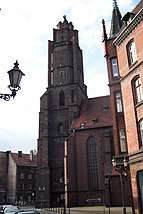
.jpg)
.jpg)

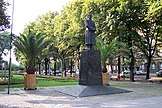
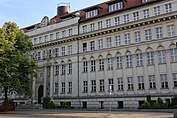
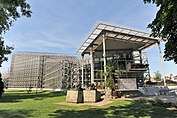
.jpg)

